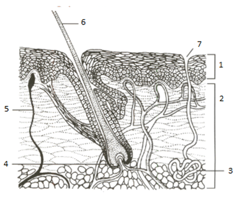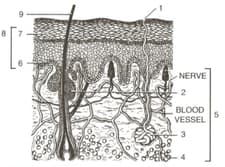Observe the figure given below and answer the following questions:

(i) Label the parts marked 1- 7.
(ii) State one function of each of the following: part 2, part 3 and part 4.
(iii) In which of the part shown above is the brown pigment present?

Important Questions on The Skin
How does our skin provide protection to our body against the following:
Entry of germs.
How does our skin provide protection to our body against the following:
Entry of harmful ultraviolet rays

State one main function of the following part:
Part 4
Which among the following in the items in the following list are not the function of human skin.
Sensation, respiration, storage of glycogen, excretion, digestion, temperature regulation, synthesis of vitamin-D, secretion of the hormone.

Part 4 may add to one’s good appearance or the “figure”. State one example of this function which may be common to both men and women.

